Alexandria, Why?
II.The Beginnings of the Cinema Industry in Alexandria
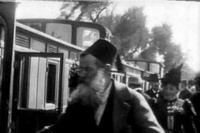
Still from Lumiere film showing the train station
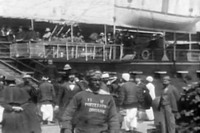
Still from Lumiere film showing the port
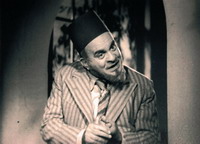
Fawzi Gazayerli
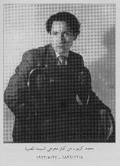
Mohamed Karim
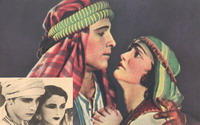
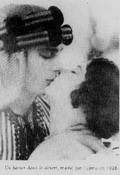
A Kiss in the Desert (Qoublah fî-l-sahrâ’). Badr Lama in the sultry tradition of Valentino
The first screening of a motion picture in Egypt was in Alexandria. The port was of course the first point of entry into the country, but it provided an atmosphere that was more tolerant towards innovations and creativity, so that it was in Alexandria that the Lumière Brothers chose to show their short film on 5 November 1896 in one of the halls of the Toussoun Bourse (the Café Zawani), less than a year after it was first shown to the world in Le Grand Café in Paris. It was immediately cause for much talk and wonder. One of the issues it raised was the vast difference between East and West in such matters. An anonymous writer in El Mou’ayed 12 November 1986 laments how far behind the East is, but how capable of catching up if people applied themselves:
“When Will We Catch Up With Them?”
I will not go into all those things people wonder about regarding the affairs of foreigners, for endless tomes are needed to explain that. There are all sorts of evidence for us to see and almost touch with our fingers, to admit that we are as far behind them as a tortoise is from a hare. But what has made me use this title is not a futile matter which can be comprehended by anybody who has a heart or heard and was witness. What has happened is that a few days ago some foreigners came to Alexandria with a camera capable of capturing motion pictures, which they call “cinematograph”. They presented it in a spacious hall in the Toussoun Pasha Bourse. An incredible number of people gathered round to watch it, and I among them. I left intoxicated by the wonders I had seen.
This marvelous invention which has aroused such amazement has also made me aware of a multitude of things, the most important of which is that I apprehended the secret of the progress of the foreigners. I found out that we would be no less than them if we had the same material, and if, like them, we related work to science and linked the tangible with the intangible.
Indeed, how could a scholar in their country not progress towards invention and creativity, towards generating wondrous things in his works? At school, he finds all the tools of science readily available to him, present before his eyes to reveal to him the mysteries of knowledge. This he receives, opening to him the closed doors of science and invention. He leaves school with his mind full of all that is necessary for the progress of his country and the race against others to get the happiness and leisure we see the foreigners enjoying. Then, wherever we turn, in the capitals of Europe and its flourishing cities, we see wonderful museums and exhibitions, scientific and political clubs, and industrial and artistic offices and gatherings. If an ignoramus were to visit them once a week, he would become a scientist in a few years. …
If we know all this, and also that trade, industry and agriculture are resources in the lands of the foreigners, … which make life easier for them and eliminate the fear of hunger and poverty that is so firmly fixed in our country. If we know all this we will no longer hesitate to confess that to compare us Orientals to the West is to compare the dead to the living or earth to sky. All we can do is lament our luck, wail at our destiny, and grieve that our government is in the iron grip of the foreigners. The souls of its people are rising to their throats from harsh pressure and murderous oppression. Then there is no harm in blaming our rich, who have made of their safes a graveyard of piles of money at which termites are gnawing. …
This is all that came to my mind when I saw that wonderful machine I have referred to. I left thinking that as long as we were proceeding down that road, we were heading for an inevitable abyss that has been dug for us by the progress and civilization of the foreigners. If we do not do as our ancestors have done, and shake off the dust of apathy, we will be overwhelmed by their flood. Oh, people, our only salvation lies in following in their footsteps and making the progress of our country our only aim, so that we can catch up with them. I showed in today’s letter, that described the progress of the West, the beauty of the cinematograph (motion pictures).
He little knew that his words would soon come true, and if in 1896 a foreign film was shown in Alexandria, then in a few years Alexandrians would themselves be producing their own films. Yet it was still difficult to determine who exactly those Alexandrians were. In the beginning they were all foreigners – first French then Italians – but eventually there were Egyptians too. Despite the liberal spirit of tolerance that reigned in the 19th and first half of the 20th centuries, the relationship between Egyptians and foreigners could be uneasy at times. Egyptians could not forget that their country was occupied by the British, and that most of the top posts, trade and wealth were in the hands of the foreigners. But in general the feeling among Egyptians was not rejection of this Western form of art and technology, but a proud determination to be as good by creating their own film industry. It was Aziz and Dorés, the famous Alexandrian photographers, who made the first cinematic film in 1907, The Visit of Khedive Abbas Helmi II to the Scientific Institute of the Sidi Abu el Abbas Mosque. This has been documented in Ahmed el Hadari’s Tarikh el cinema fi Misr (Cairo, 1989) under the title “The first local cinematic filming”, thereby avoiding the thorny question of determining whether it was Egyptian or not. But when he came to 1914 he decided to use the subtitle “Egyptian films” when he documented another Aziz and Dorés production: the reception held for the hero Aziz Bey el Masri on his arrival at Alexandria. By 1922 the film Soloman’s Ring was classified as an Egyptian short narrative film, though the director was Léonard Laricci and the photographer was Alvise Orfanelli. With the production of the long narrative film, In the Land of Tutankhamun(1923), the foreign filmmaker grew to be acknowledged as a friend who had done the country a favour. The Italian director, Victor Rossito, was thanked over and over in the papers for having presented Egypt and its people as being noble and beautiful. The cinema magazine El Sowar el Mutaharika published an article (26 July 1923) saying: “We congratulate Monsieur Victor Rossito for the cinematographic reel that he made and on which he spent 2,900 pounds and did not fear failure. … It was an Italian man’s idea to teach peasants by means of the cinema. … His first work is a film with an Egyptian content, using a foreign form.” This is perhaps an apt description of the collaboration between foreigners and Egyptians to produce those early films. Ahmed el Hadari resolves the issue when he emphatically states: “It is an Egyptian film, because it was written, directed and funded by Victor Rossito, one of the foreigners living in Egypt – a well known lawyer. And if Rossito was of Italian origin, his judgment here is the judgment of all foreigners who worked in the cinema in Egypt. These are Egyptian films to be labelled ‘Made in Egypt’” (p. 72). Alexandrians involved in the various branches of the world of the cinema would encompass all sorts of identities: those born in Alexandria of Egyptian or foreign origins, those who were born in Cairo but came to work in Alexandria when the cinema started there, and those who were born in Alexandria but moved to Cairo with the cinema when it moved there.
One of the special gifts of Alexandrians was that they were polyglot. It was natural for Alexandrians to be fluent at three languages and know a smattering of another two. Italian had succeeded Turkish as the lingua franca, but Italian had been replaced by French. Nevertheless, there was soon a demand in Alexandria that the films be translated into Arabic. By 1912 el Cinema el Misreyah, located in a popular area in Alexandria, had started providing Arabic subtitles on a separate screen. It was an instant success. Still, in the early days the first specialized cinema magazine was Cinégraphe Journale, issued in Alexandria in 1919. It was Francophone, for French remained the language of culture, even if Arabic was soon to be used in the films themselves and in Arabic specialized magazines such as El Sowar el Mutahrika and Ma‘rad el Cinema (which appeared three times in Alexandria: 1924, 1925, 1927). It was also in Alexandria that the film Dr Farahat (1935) directed by Alexandrian Togo Mizrahi was translated into Greek, so that the first Greek films were produced in Alexandria.
Mainly because of the atmosphere that encouraged innovation and enterprise, it was in Alexandria that the industry took root. In the absence of specialization in those early days, many of the principal figures in the field wrote, filmed, directed, produced and sometimes acted in the films. They were cinematographers rather than directors or cameramen. The first cinemas, films, studios, cinema companies, specialized magazines, and critics were in Alexandria. For instance, the first cinema theatre in Egypt was opened on 30 January 1897 – a few months after the projection of the Lumière film – in Mahatet Misr Street (Rue de la Gare du Caire) in Alexandria. It was called Cinématographe Lumière. Soon afterwards, on 9 March 1897, Monsieur Promio was sent by the Lumière Brothers to shoot a number of films in Egypt. The first scenes they shot were in Alexandria, making their film Place des Consuls à Alexandrie the first film ever to be shot in Egypt.
But for films to be made in Egypt, rather than simply shot, a production company had to be established. This did happen when one was founded in Alexandria by Aziz and Cornel in 1917 with several other Italian investors and the assistance of Banco di Roma. This company, SITCIA, also created the first studio in Egypt in Hadra, Alexandria.
From Alexandria, too, came the first cinema critic in the country. The Egyptian, El Sayed Hassan Gomaa, started out as a school teacher in Alexandria, and became editor-in-chief of Ma‘rad el Cinema until it shut down. Then he moved to Cairo where he worked for Dar el Helal, and eventually became editor of El Kawakeb.
Egyptians and foreigners working together in Alexandria created films that reflect the cosmopolitanism and tolerance of this multi-ethnic, multi-denominational city. Different religions are portrayed in Bayoumi’s film Barsoum Looks for Employment (Barsoum yabhas ‘an wazifa) 1923/4, where Beshara Wakim (a Coptic Christian) plays the role of a Muslim, Abdel Hamid Zaki (a Muslim actor) plays the role of the Christian, and a Jew, Victor Cohen, is the banker. In A Kiss in the Desert (Qoublah fî-l-sahrâ’) 1928, the team includes a variety of nationalities, such as Ibrahim and Badr Lama (Chileans of Palestinian origin), Alvise Orfanelli(Italian), and Ibrahim Zoulficar (Egyptian), to name just a few.
Nevertheless, the demands of the market eventually affected the site of the industry. Simply because the population in Cairo was greater, the cinema became more lucrative in the capital. Also, foreign filmmakers realized that for a film to succeed in Egypt, the actor had to be an Egyptian star, someone the population loved and could identify with. As most theatre troupes had moved to Cairo, it was in the capital that actors could be found from among whom the cinema stars would be recruited. And, most importantly, in 1934 Talaat Harb created Studio Misr, which was more sophisticated than anything in Alexandria, thereby attracting all cinematographers to it. So the cinema industry gradually moved to Cairo. Alexandria was left with the glory of having founded the Egyptian cinema – an industry that was soon to conquer not only Egypt but the entire Arab world.
References
- Abou Chadi, Ali. A Chronology of the Egyptian Cinema Over One Hundred Years 1896-1994. Cairo: Supreme Council for Culture, 1998.
- El Hadari, Ahmed. Tarikh el Cinema fi Misr: 1896-1930. Cairo: Publications of the Cinema Club, 1989.
- Mohamed Karim
A Kiss in the Desert (Qoublah fî-l-sahrâ’). Badr Lama in the sultry tradition of Valentino

